
Body piercing,
tattooing,
painting
in the galleries
of the
Penn Museum.
|
|

woman
with face painting Papua,
New Guinea, 1982
Decorated
for an annual festival.
|
When
most people think of body painting, the image that
comes to mind is more likely to be that of a "wild" person
such as the New Guinea woman pictured at left as opposed
to that of "wild" American men shown at right. Yet body
painting is worldwide, the most ancient and direct method
of corporeal decoration. We all paint our bodies for reasons
of identification, ritual, or beauty. For the New Guinea
woman, body painting is a means of conveying social messages
about her identity with a group. In much the same way,
the designs on the faces and chests of this year's World
Cup fans are clear signals about their loyalty to Team
USA.
|

USA!...USA!...USA!, Paris,
1998
Decorated
for the yearly World Cup Games, their body painting has
a ritual component and serves as a form of identification.
|
|
|
Americans
often paint each others' faces at community gatherings. Visit
a block-party or fair in the United States and you're sure to
see at least one person painting children's faces.
|
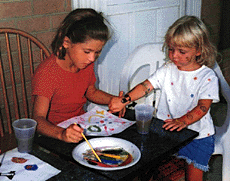
|
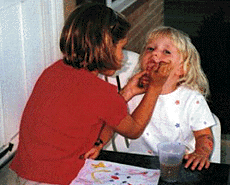
|
|
face
painting at a block party, suburban
Philadelphia, 1998
|

|
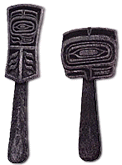
Tlingit face stamps,
Alaska, 1905
|
The Tlingit of southeast Alaska used face painting at gatherings.These
face stamps (pictured left), carved with
the emblems of clans, were dipped into paint and pressed onto
the cheeks of women before going to a potlatch, a type of annual
community feast. At the feast, it was easy to identify the clan
a woman belonged to by looking at her face.
|
|
The
most common form of body painting in America is also the easiest
to overlook: cosmetics. A daily ritual for most women and
the envy of small girls, wearing cosmetics is undoubtedly the
most prevalent type of body painting in the world today. It's
a multi-billion dollar industry -- with an increasing male market
as well. On the surface, makeup is used to mask or disguise unsightly
pimples, scars, or what seem to be unflattering natural features.
But on a deeper level, there are other reasons for using makeup.
For example, some would argue that the current makeup mania in
American society is a byproduct of the media, and that American
men and women, constantly presented with attractive images of
models, movie stars, and musicians, inevitably want to imitate
the way they look.
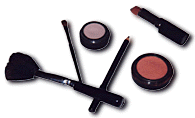
|
Buddha
with dot on forehead. Museum Object Number: C405A, China,
A.D. 1279-1368
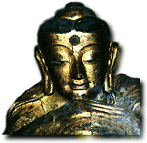
For centuries, people all over the world have used makeup to enhance
their natural features. In India, in addition to makeup
for the eyes and lips, a dot on the forehead of women is included
in the daily beauty routine.
|
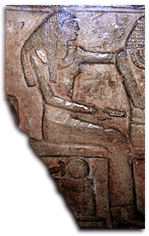
Funerary stela,
showing a woman taking her mirror and makeup box with her to the
afterlife,
Egypt,
ca. 2130-2000 B.C.
|
Makeup was
an important facet in the daily lives of ancient Egyptian men
and women. Their cosmetics were made from various minerals
and included henna, ochre, and kohl. It could be applied to the
living as well as to mummies. The detail (left)
from a funeral stele displayed in the Museum's Egyptian
gallery shows a seated woman, traveling to the Afterlife and
taking her mirror and makeup box (beneath her chair) with her
on the journey. For ancient Egyptians, one's image was connected
to the idea of an afterlife.
Canaanite
men and women both wore makeup. The cosmetic palette and cosmetic
spoons (above) are from the Museum's Canaan
and Ancient Israel gallery. |
|
Cosmetics
also served a practical purpose in Egypt and India. Kohl was worn
as eyeliner, and helped to cut the glare from the sun. Today,
atheletes put black (and white) smudges under their eyes for the
same purpose.
|

|
Patrick
Rafter blocking the sun's glare,
U.S.
Open, 1998
|
|
The most recent
innovation in modern cosmetics is micro pigment implantation,
which is semi-permanent makeup applied by a process similar to
tattooing. Unlike a tattoo, however,
the ink will fade in about five years. The process was originally
created to cover up unsightly birthmarks such as the dark-red,
port-wine marks that some people have. Today it is being used
to add convenience to everyday life. A woman can have her entire
face made up to save the time of applying makeup each day. For
example, she can have eyeliner, lipstick, and blush applied and
it will never wash off.
|
|
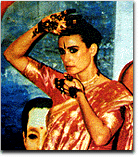
Demi does mehndi,
Los Angeles, 1998
|
Staining
the nails, skin and hair with henna is the favorite
way of enhancing beauty among women in the Middle East and
is becoming increasingly popular in the United States. Mehndi,
commonly referred to as henna, is the powder form. Henna
is the dye that comes from mixing the powder with catechu,
an astringent substance, obtained from various trees and
shrubs. The red powder form of henna can be obtained by
crushing the berries from a certain plant. Henna is a popular
way to make semi-permanent decorative designs on the skin.
There are two types of henna: black and red.
|
|
Black
henna (saumer) is reserved for the soles of the feet and
hands while red henna is used for the tips of the fingers
and toes. Red henna involves the additional use of a paste
made from powdered lime, nura, and crystal amoniac, shanadah.
This makes an orange paste that turns black as it dries,
leaving a design on the skin that remains for approximately
20-30 days. Red and black henna can often be purchased at
international grocery stores.
In India,
henna art was often reserved for special occasions such
as weddings. The application of henna can take up to 6 hours.
After all the ingredients are mixed and the designs are
applied, the painted areas shouldn't be disturbed for 6
hours or more, depending upon the desired richness of color
and lifespan of the design. This process, the same in India
and in the United States, is lengthy, but is nevertheless
seen more frequently in everyday activities.

|
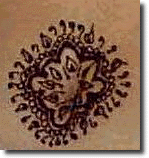
Henna design
on navel,
NYC,
1998
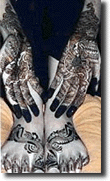
Feet and hands decorated for wedding, India,
1998
|
|
|

